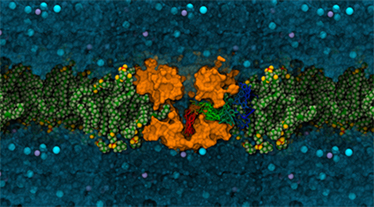
Corry Group - Transport proteins and computational biophysics
Corry group's research examines the structure and function of membrane proteins.
Research themes
About
Our research examines the structure and function of membrane proteins including ion channels, transporters and receptors. We use cutting edge computational methods to understand the mechanisms by which these and other membrane proteins can identify and transport molecules across the cell membrane, how they undergo conformational changes to control this transport, and how they are influenced by the surrounding membrane. In addition we are interested in studying transport in other kinds of pores, be they in proteins, crystaline materials or synthetic membranes. Gaining a fundamental understanding of the operation of biological pores has allowed us to design synthetic porous membranes that can be used for the desalination of sea water or to remove dangerous contaminants from water supplies.
Proteins and macromolecules can be difficult to study due to their size, functioning at the interface of microscopic molecular behaviour and macroscopic mechanical behaviour. To investigate them we use a combination of computational techniques including quantum calculations, atomistic and coarse grained molecular dynamics, and macroscopic modelling. As experts in molecular simulation we apply our skills to help many other groups better understand the structure and function of their proteins of interest. In addition we utilise membrane transport assays and FRET microscopy (Förster Resonance Energy Transfer) to experimentally study the conformational changes of proteins as they function, and design computational codes to better design and interpret FRET experiments.
Awards
- Janet Elspeth Crawford Postgraduate Leadership Prize, 2024
- Vice-Chancellor’s Award for Teaching Excellence, 2024
- Vice-Chancellor’s Commendation for Excellence in Tutoring and Demonstrating, 2024
- Janet Elspeth Crawford Postgraduate Leadership Prize, 2024
- The Hirota Naora Award, 2023
- College of Science Dean's Commendations of Excellence in Education 2022 - Teaching Excellence, 2022
- Replacing Animals in Medical Research Grant, 2021
- Vice Chancellor's Award for Excellence in Education, for Outstanding Contribution to Student Learning, 2020
- College of Science Professional staff & Excellence in Education award, 2019
- Young Biophysicist Award, 2018
- ARC Future Fellowship, 2013
- Eureka Prize Finalist, 2011
- Young Tall Poppy Science Award, 2011
- Young Scientist of the Year (WA), 2005
- Young Biophysicist Award, 2005
Publications
Publications
- Akbari, A, Meragawi, S, Martin, S et al 2018, 'Solvent Transport Behavior of Shear Aligned Graphene Oxide Membranes and Implications in Organic Solvent Nanofiltration', ACS Applied Materials and Interfaces, vol. 10, no. 2, pp. 2067-2074pp.
- Buyan, A, Sun, D & Corry, B 2018, 'Protonation state of inhibitors determines interaction sites within voltage-gated sodium channels', PNAS - Proceedings of the National Academy of Sciences of the United States of America, vol. 115, no. 14, pp. 3135-3144pp.
- Corry, B 2018, 'Physical basis of specificity and delayed binding of a subtype selective sodium channel inhibitor', Scientific Reports, vol. 8, no. 1356, pp. 1-10pp.
- Corry, B 2018, 'The naked truth about K+ selectivity', Nature Chemistry, vol. 10, no. 8, pp. 799-800pp.
- Corry, B 2017, 'Mechanisms of selective ion transport and salt rejection in carbon nanostructures', MRS Bulletin, vol. 42, no. April 2017, pp. 306-310.
- Corry, B 2017, 'Simulating the Access and Binding of Subtype Selective Sodium Channel Inhibitors', 61st Annual Meeting of the Biophysical-Society, Conference Organising Committee, TBC, pp. 1pp.
- Cheng, Q, Shah, N, Broer, A et al 2017, 'Identification of novel inhibitors of the amino acid transporter B0AT1 (SLC6A19), a potential target to induce protein restriction and to treat type 2 diabetes', British Journal of Pharmacology, vol. 174, no. 6, pp. 468-482pp.
- Chen, R, Buyan, A & Corry, B 2017, 'Voltage-Gated Sodium Channel Pharmacology: Insights From Molecular Dynamics Simulations', Advances in Pharmacology, vol. 79, pp. 255-285pp.
- Corry, B 2016, 'Computer Simulation of Ion Channels', in Carmen Domene (ed.), Computational Biophysics of Membrane Proteins, The Royal Society of Chemistry, United Kingdom, pp. 161-196pp.
- Mattia, D, Corry, B, Lockerby, D et al 2016, 'Nanostructured carbon membranes for breakthrough filtration applications: advancing the science, engineering and design', Philosophical Transactions of the Royal Society Series A, vol. 374, no. 2060, pp. 1-2pp.
- Agarwal, V, Toshniwal, P, Smith, N et al 2016, 'Enhancing the efficacy of cation-independent mannose 6-phosphate receptor inhibitors by intracellular delivery', Chemical Communications, vol. 52, no. 2, pp. 327-330.
- Thomas, M & Corry, B 2016, 'A computational assessment of the permeability and salt rejection of carbon nanotube membranes and their application to water desalination', Philosophical Transactions of the Royal Society Series A, vol. 374, no. 2060, pp. 1-20.
- Smith, N & Corry, B 2016, 'Mutant bacterial sodium channels as models for local anesthetic block of eukaryotic proteins', Channels, vol. 10, no. 3, pp. 225-237.
- Bavi, N, Corry, B, Cox, C et al 2016, 'The role of MscL amphipathic N terminus indicates a blueprint for bilayer-mediated gating of mechanosensitive channels', Nature Communications, vol. 7, no. -, pp. 11984-11984.
- Søndergaard, S, Aznauryan, M, Haustrup, E et al 2015, 'Dynamics of Fluorescent Dyes Attached to G-Quadruplex DNA and their Effect on FRET Experiments', ChemPhysChem, vol. 16, no. 12, pp. 2562-2570.
- Thomas, M & Corry, B 2015, 'Thermostat choice significantly influences water flow rates in molecular dynamics studies of carbon nanotubes', Microfluidics and Nanofluidics, vol. 18, no. 1, pp. 41-47.
- Li, M, Jazayeri, D, Corry, B et al 2015, 'A functional correlate of severity in alternating hemiplegia of childhood', Neurobiology of Disease, vol. 77, pp. 88-93.
- Walczewska-Szewc, K, Deplazes, E & Corry, B 2015, 'Comparing the Ability of Enhanced Sampling Molecular Dynamics Methods to Reproduce the Behavior of Fluorescent Labels on Proteins', Journal of Chemical Theory and Computation (JCTC), vol. 11, no. 7, pp. 3455-3465.
- Corry, B 2015, 'Long Timescale Molecular Dynamics Simulations for Understanding Ion Channel Function', in Ronald J. Clarke and Mohammed A.A. Khalid (ed.), Pumps, Channels and Transporters:Methods of Functional Analysis, Wiley, United States of America, pp. 411-437pp.
- Thomas, M, Corry, B, Chung, S et al 2015, 'Modelling selective transport and desalination in nanotubes', in Ying (Ian) Chen (ed.), Nanotubes and Nonosheets, CRC Press, Taylor & Francis Group, London, pp. 305-330pp.
- He, Z, Corry, B, Lu, X et al 2014, 'A mechanical nanogate based on a carbon nanotube for reversible control of ion conduction', Nanoscale, vol. 6, no. 7, pp. 3686-3694.
- Thomas, M, Corry, B & Hilder, T 2014, 'What have we learnt about the mechanisms of rapid water transport, ion rejection and selectivity in nanopores from molecular simulation?', Small, vol. 10, no. 8, pp. 1453-1465.
- Hilder, T, Corry, B & Chung, S 2014, 'Multi-ion versus single-ion conduction mechanisms can yield current rectification in biological ion channels', Journal of Biological Physics, vol. 40, no. 2, pp. 109-119.
- Corry, B 2014, 'Assessing the potential permeability and salt rejection of membranes incorporating carbon nanotubes', Nanoscale Science and Engineering Forum 2013 - Core Programming Area at the 2013 AIChE Annual Meeting: Global Challenges for Engineering a Sustainable Future, Curran Associates, Inc., Online, pp. 197-197.
- Smith, N, Vrielink, A, Attwood, P et al 2014, 'Binding and Channeling of Alternative Substrates in the Enzyme DmpFG: a Molecular Dynamics Study', Biophysical Journal, vol. 106, no. 8, pp. 1681-1690.
- Walczewska-Szewc, K & Corry, B 2014, 'Do bifunctional labels solve the problem of dye diffusion in FRET analysis?', Physical Chemistry Chemical Physics, vol. 16, no. 35, pp. 18949-18954.
- Martin, L, Chao, R & Corry, B 2014, 'Molecular dynamics simulation of the partitioning of benzocaine and phenytoin into a lipid bilayer', Biophysical Chemistry, vol. 185, pp. 98-107.
- Martin, L & Corry, B 2014, 'Locating the Route of Entry and Binding Sites of Benzocaine and Phenytoin in a Bacterial Voltage Gated Sodium Channel', PLOS Computational Biology, vol. 10, no. 7, pp. e1003688-e1003688.
- Smith, N, Swaminathan Iyer, K & Corry, B 2014, 'The confined space inside carbon nanotubes can dictate the stereo- and regioselectivity of Diels-Alder reactions', Physical Chemistry Chemical Physics, vol. 16, no. 15, pp. 6986-6989.
- Kaczmarski, J & Corry, B 2014, 'Investigating the size and dynamics of voltage-gated sodium channel fenestrations A molecular dynamics study', Channels, vol. 8, no. 3, pp. 264-277.
- Walczewska-Szewc, K & Corry, B 2014, 'Accounting for dye diffusion and orientation when relating FRET measurements to distances: three simple computational methods', Physical Chemistry Chemical Physics, vol. 16, no. 24, pp. 12317-12326.
- Corry, B, Lee, S & Ahern, C 2014, 'Pharmacological Insights and Quirks of Bacterial Sodium Channels', in W.Rosenthal (ed.), Handbook of Experimental Pharmacology, Springer, Heidelberg New York Dordrecht London, pp. 251-267.
- Corry, B, Cranfield, C & Martinac, B 2013, 'Structure and physiological role of ion channels studied by fluorescence spectroscopy', in R A Meyers (ed.), Encyclopedia of Analytical Chemistry (2nd ed), John Wiley & Sons Inc, New Jersey, pp. 1-26pp.
- Richards, L, Richards, B, Corry, B et al 2013, 'Experimental energy barriers to anions transporting through nanofiltration membranes', Environmental Science and Technology, vol. 47, no. 4, pp. 1968-1976.
- Thomas, M, Jayatilaka, D & Corry, B 2013, 'An Entropic Mechanism of Generating Selective Ion Binding in Macromolecules', PLOS Computational Biology, vol. 9, no. 2, pp. e1002914-e1002914.
- Thomas, M, Jayatilaka, D & Corry, B 2013, 'How does overcoordination create ion selectivity?', Biophysical Chemistry, vol. 172, pp. 37-42.
- Corry, B 2013, 'Na+/Ca2+selectivity in the bacterial voltage-gated sodium channel NavAb', PeerJ, vol. 1.
- He, Z, Zhou, J, Lu, X et al 2013, 'Ice-like water structure in carbon nanotube (8,8) induces cationic hydration enhancement', Journal of Physical Chemistry C, vol. 117, no. 21, pp. 11412-11420.
- He, Z, Zhou, J, Lu, X et al 2013, 'Bioinspired graphene nanopores with voltage-tunable ion selectivity for Na+ and K+', ACS Nano, vol. 7, no. 11, pp. 10148-10157.
- Smith, N, Tie, W, Flematti, G et al 2013, 'Mechanism of the dehydrogenase reaction of DmpFG and analysis of inter-subunit channeling efficiency and thermodynamic parameters in the overall reaction', The International Journal of Biochemistry and Cell Biology, vol. 45, no. 8, pp. 1878-1885.
- Nemkevich, A, Spackman, M & Corry, B 2013, 'Simulations of guest transport in clathrates of Dianin's compound and hydroquinone', Chemistry, A European Journal, vol. 19, no. 8, pp. 2676-2684.
- Mustafa, S, Hannagan, J, Rigby, P et al 2013, 'Quantitative Forster resonance energy transfer efficiency measurements using simultaneous spectral unmixing of excitation and emission spectra', Journal of Biomedical Optics, vol. 18, no. 2, pp. 26024-26024.
- Corry, B & Smith, N 2012, 'The role of thermodynamics and kinetics in ligand binding to G-quadruplex DNA', Chemical Communications, vol. 48, no. 71, pp. 8958-8960.
- Nemkevich, A, Corry, B & Spackman, M 2012, 'Computational study of methyl group dynamics in the hydroquinone clathrate of acetonitrile', Physical Chemistry Chemical Physics, vol. 14, no. 5, pp. 1570-1572.
- Richards, L, Schafer, A, Richards, B et al 2012, 'Quantifying barriers to monovalent anion transport in narrow non-polar pores', Physical Chemistry Chemical Physics, vol. 14, no. 33, pp. 11633-11638.
- Richards, L, Schafer, A, Richards, B et al 2012, 'The importance of dehydration in determining ion transport in narrow pores', Small, vol. 8, no. 11, pp. 1701-1709.
- Deplazes, E, Louhivuori, M, Jayatilaka, D et al 2012, 'Structural Investigation of MscL Gating Using Experimental Data and Coarse Grained MD Simulations', PLOS Computational Biology, vol. 8, no. 9.
- Smith, N, Vrielink, A, Attwood, P et al 2012, 'Biological Channeling of a Reactive Intermediate in the Bifunctional Enzyme DmpFG', Biophysical Journal, vol. 102, no. 4, pp. 868-877.
- Deplazes, E, Jayatilaka, D & Corry, B 2012, 'ExiFRET: flexible tool for understanding FRET in complex geometries', Journal of Biomedical Optics, vol. 17, no. 1, pp. 11005-11005.
- Smith, N, Labrunie, G, Corry, B et al 2011, 'Unraveling the relationship between structure and stabilization of triarylpyridines as G-quadruplex binding ligands', Organic and Biomolecular Chemistry, vol. 9, no. 17, pp. 6154-6162.
- Majumder, M & Corry, B 2011, 'Anomalous decline of water transport in covalently modified carbon nanotube membranes', Chemical Communications, vol. 47, no. 27, pp. 7683-7685.
- Nemkevich, A, Spackman, M & Corry, B 2011, 'Mechanism of Concerted Hydrogen Bond Reorientation in Clathrates of Dianin's Compound and Hydroquinone', Journal of the American Chemical Society, vol. 133, no. 46, pp. 18880-18888.
- Corry, B 2011, 'Water and ion transport through functionalised carbon nanotubes: implications for desalination technology', Energy and Environmental Science, vol. 4, no. 3, pp. 751-759.
- Deplazes, E, Jayatilaka, D & Corry, B 2011, 'Testing the use of molecular dynamics to simulate fluorophore motions and FRET', Physical Chemistry Chemical Physics, vol. 13, no. 23, pp. 11045-11054.
- Thomas, M, Jayatilaka, D & Corry, B 2011, 'Mapping the Importance of Four Factors in Creating Monovalent Ion Selectivity in Biological Molecules', Biophysical Journal, vol. 100, no. 1, pp. 60-69.
- Song, C & Corry, B 2011, 'Testing the Applicability of Nernst-Planck Theory in Ion Channels: Comparisons with Brownian Dynamics Simulations', PLOS ONE (Public Library of Science), vol. 6, no. 6, pp. e21204-e21204.
- Corry, B, Hurst, A, Pal, P et al 2010, 'An improved open-channel structure of MscL determined from FRET confocal microscopy and simulation', Journal of General Physiology, vol. 136, no. 4, pp. 483-494.
- Xie, H, Ho, L, Truelove, M et al 2010, 'Fluorescent triphenyl substituted maleimide derivatives: synthesis, spectroscopy and quantum chemical calculations', Journal of Fluorescence, vol. 20, no. 5, pp. 1077-1085.
- Ruhayel, R, Corry, B, Braun, C et al 2010, 'Determination of the Kinetic Profile of a Dinuclear Platinum Anticancer Complex in the Presence of Sulfate: Introducing a New Tool for the Expedited Analysis of 2D [1H, 15N] HSQC NMR Spectra', Inorganic Chemistry, vol. 49, no. 23, pp. 10815-10819.
- Nemkevich, A, Burgi, H, Spackman, M et al 2010, 'Molecular dynamics simulations of structure and dynamics of organic molecular crystals', Physical Chemistry Chemical Physics, vol. 12, no. 45, pp. 14916-14929.
- Song, C & Corry, B 2010, 'Ion conduction in ligand gated ion channels: Brownian dynamics studies of four recent crystal structures', Biophysical Journal, vol. 98, no. 3, pp. 404-411.
- Corry, B & Song, C 2009, 'Intrinsic Ion Selectivity of Narrow Hydrophobic Pores', Journal of Physical Chemistry C, vol. 113, no. 18, pp. 7642-7639.
- Smith, N, Corry, B, Swaminathan, I et al 2009, 'A microfluidic platform to synthesise a G-quadruplex binding ligand', Lab on a Chip, vol. 9, pp. 2021-2025.
- Dittrich, B, Warren, J, Fabbiani, F et al 2009, 'Temperature dependence of rotational disorder in a non-standard amino acid from X-ray crystallography and molecular dynamics simulation', Physical Chemistry Chemical Physics, vol. 11, pp. 2601-2609.
- Song, C & Corry, B 2009, 'Computational study of the transmembrane domain of the acetylcholine receptor', European Biophysics Journal, vol. 38, pp. 961-970.
- Song, C & Corry, B 2009, 'Role of acetylcholine receptor domains in ion selectivity', Biochimica et Biophysica Acta: Biomembranes, vol. 1788, pp. 1466-1473.
- Corry, B & Martinac, B 2008, 'Bacterial mechanosensitive channels: Experiment and theory', Biochimica et Biophysica Acta: Biomembranes, vol. 1778, no. 9, pp. 1859-1870.
- Corry, B & Jayatilaka, D 2008, 'Simulation of structure, orientation, and energy transfer between AlexaFluor molecules attached to MscL', Biophysical Journal, vol. 95, no. 6, pp. 2711-2721.
- Corry, B 2008, 'Designing carbon nanotube membranes for efficient water desalination', Journal of Physical Chemistry B, vol. 112, no. 5, pp. 1427-1434.
- Corry, B, O'Mara, M & Chung, S 2004, 'Permeation Dynamics of Chloride Ions in the CIC-O and CIC-1 Channels', Chemical Physics Letters, vol. 386, pp. 233-238.
- Corry, B, O'Mara, M & Chung, S 2004, 'Conduction Mechanisms of Chloride Ions in CIC-Type Channels', Biophysical Journal, vol. 86, pp. 846-860.
- Corry, B & Kuyucak, S 2003, 'Dielectric Self-energy in Poisson-Boltzmann and Poisson-Nernst-Planck Models of Ion Channels', Biophysical Journal, vol. 84, pp. 3594-3606.
- Edwards, S, Corry, B, Kuyucak, S et al 2002, 'Continuum Electrostatics Fails to Describe Ion Permeation in the Gramicidin Channel', Biophysical Journal, vol. 83, pp. 1348 - 1360.
- Corry, B, Hoyles, M, Allen, T et al 2002, 'Reservoir Boundaries in Brownian Dynamics Simulations of Ion Channels', Biophysical Journal, vol. 82, pp. 1975 - 1984.
- Corry, B, Allen, T, Kuyucak, S et al 2001, 'Mechanisms of Permeation and Selectivity in Calcium Channels', Biophysical Journal, vol. 80, pp. 195-214.
- Corry, B, Kuyucak, S & Chung, S 2000, 'Tests of Continuum Theories as Models of Ion Channels. II. Poisson-Nernst-Planck Theory versus Brownian Dynamics', Biophysical Journal, vol. 78, pp. 2364-2381.
- Corry, B, Allen, T, Kuyucak, S et al 2000, 'A model of calcium channels', Biochimica et Biophysica Acta: International journal of Biochemistry and Biophysics, vol. 70883, pp. 1-6.
- Corry, B, Kuyucak, S & Chung, S 2000, 'Invalidity of continuum theories of electrolytes in nanopores', Chemical Physics Letters, vol. 320, pp. 35-41.
- Moy, G, Corry, B, Kuyucak, S et al 2000, 'Tests of Continuum Theories as Models of Ion Channels. I. Poisson-Boltzmann Theory versus Brownian Dynamics', Biophysical Journal, vol. 78, pp. 2349-2363.
- Corry, B, Kuyucak, S & Chung, S 1999, 'Test of Poisson-Nernst-Planck theory of ion channels', Journal of General Physiology, vol. 114, pp. 597-600.
- Go to a complete list of publications on the ISI website.













